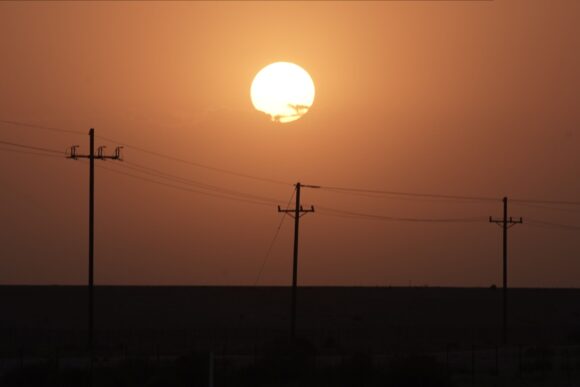A vast swath of North America from the Great Lakes to the West Coast is at risk of blackouts this summer as heat, drought, shuttered power plants and supply-chain woes strain the electric grid.
Power supplies in much of the US and part of Canada will be stretched, with demand growing again after two years of pandemic disruptions, according to an annual report. It’s among the most dire assessments yet from the North American Electric Reliability Corp., a regulatory body that oversees grid stability.
“It’s a pretty sobering report, and it’s clear the risks are spreading,” John Moura, director of reliability assessment and performance analysis, said in a press briefing. “I certainly do think it’s our most cautionary tale here.”
Climate change is partly to blame. A historic drought is covering the western US, limiting supplies of hydroelectric power, and forecasts call for a hotter-than-average summer. But the fight against global warming poses its own risks as older coal-fired plants close faster than wind farms, solar facilities and batteries can replace them.
“The pace of our grid transformation is out of sync” with the physical realities of the existing power network, Moura said.
Supply-chain snags, meanwhile, are delaying Southwest solar projects and Texas transmission lines, while coal plants are having trouble obtaining fuel amid increased exports. And power grids face a growing threat of cyberattacks because of US support for Ukraine following the Russian invasion, according to NERC.
Electricity supplies will be particularly tight in the Midwest. Across the region, enough older plants have shut down to cut generation capacity 2.3% since last summer. Demand, however, is expected to grow. Even when temperatures are normal, grid managers may need power from neighboring regions to keep air conditioners humming, and a heat wave or low wind speeds could trigger blackouts, according to the report. NERC had previously warned the Midwest could face power shortfalls as plants close, but not until 2024. The region also is missing a key transmission line damaged by a December tornado, with repairs expected to wrap up in June.
Early retirement of fossil fuel plants is an issue in other parts of the US as well. The coal and natural gas plants that continue to operate are running harder, and NERC expects them to break down more often, Moura said. The gas-fired plants in Texas that shut unexpectedly late last week during a spring heat wave underscore that risk, he said.
Throughout the West, drought will limit the output from hydroelectric dams. It even threatens power plants that draw their cooling water from the Missouri River, which is running low, according to the report. Wildfires amplified by the drought could darken skies with smoke, cutting the output from solar plants while simultaneously forcing homes with rooftop solar panels to rely more on the grid.
Last year, NERC issued a warning that was nearly as grim, saying electric grids that serve more than 40% of the U.S. population were at risk of outages. In the end, most systems held up during the heat. One notable exception was in the Pacific Northwest, where Avista Corp. resorted to rolling blackouts during a unrelenting June heat wave, leaving more than 9,000 homes and businesses without power.
Some of the states cited in the report have already issued their own summer forecasts, some more upbeat than others. The Electric Reliability Council of Texas said in a Monday report that the state — which endured a deadly, days-long blackout last year during a winter storm — has enough power to meet expected record demand from June through September, although some analysts called the report too optimistic.
“We feel very confident about summer; our reserves have gone up,” said Brad Jones, Ercot’s interim chief executive officer, during a press briefing Tuesday. Still, when supplies are strained, Texans will be asked to conserve earlier than they were in the past, Jones said. “I hope that each of you will turn to conservation as a way to both lower your bill as well as to help all of us in the market.”
California’s grid operators, in contrast, have warned that the state faces a risk of blackouts during the next three summers as the state shifts to cleaner energy. Hydropower generation has shrunk with the drought, older gas-burning plants have closed, and electricity supplies grow strained on hot summer evenings when the sun sets on the state’s many solar plants.
“We know that reliability is going to be difficult in this time of transition,” said Alice Reynolds, president of the California Public Utilities Commission, during a May 6 press conference.
–With assistance from Mark Chediak.
About the photo: The sun rises over power lines near Imperial, California, U.S., on Tuesday, Aug. 18, 2020. California is bracing for another round of rolling blackouts Tuesday as unrelenting heat drives electricity demand to an all-time high, straining a power grid that’s already been pushed to the brink of failure.
Was this article valuable?
Here are more articles you may enjoy.


 State Farm Sued Over Policies Backed by Distressed Insurer PHL
State Farm Sued Over Policies Backed by Distressed Insurer PHL  ‘Dream Is in Sight:’ Chamber, Reinsurers, Insurers Urge Florida to Stay the Course
‘Dream Is in Sight:’ Chamber, Reinsurers, Insurers Urge Florida to Stay the Course  Hermès Heir Sues Arnault and LVMH in $16 Billion Suit Over Lost Shares
Hermès Heir Sues Arnault and LVMH in $16 Billion Suit Over Lost Shares  Standard Chartered Settles $2 Billion Iranian Sanction Suit in London
Standard Chartered Settles $2 Billion Iranian Sanction Suit in London 